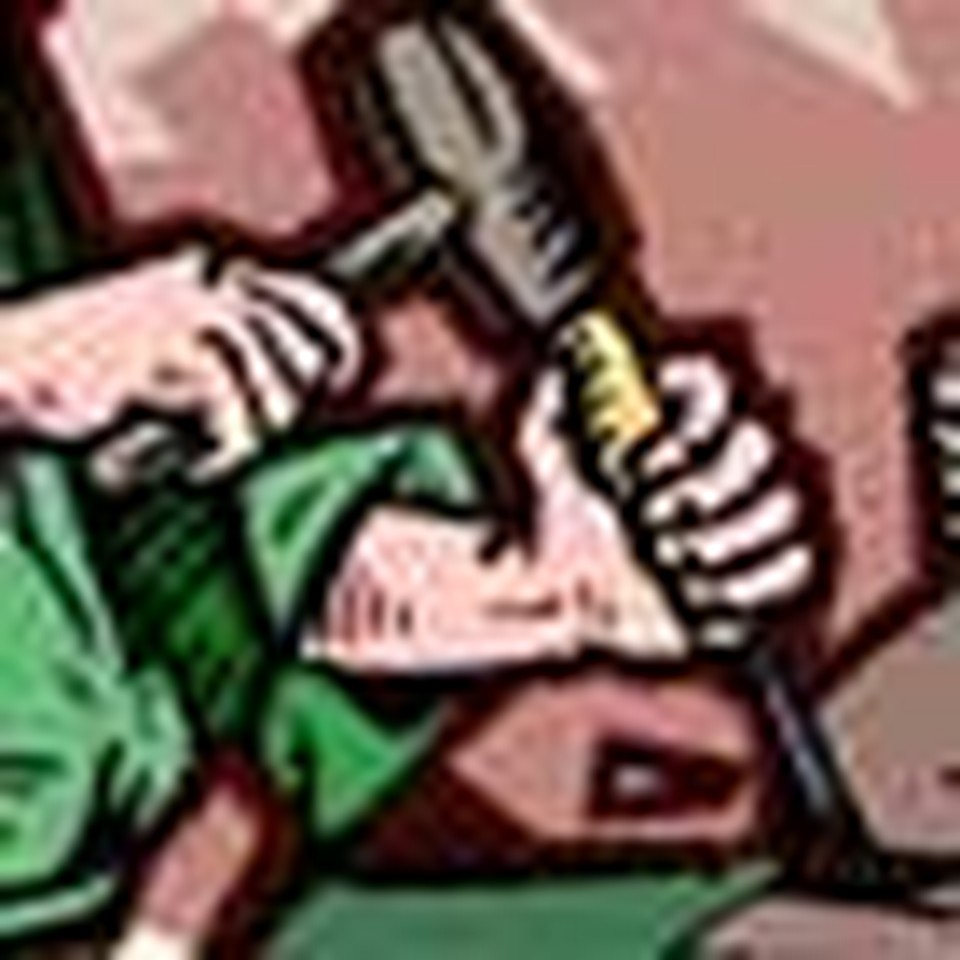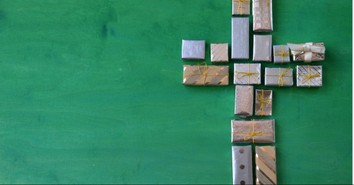Tools of the Trade
As with every profession, we need to have some professional tools on hand. Here are some of our favorite tools for making our schooling fun.
Published Sep 20, 2002

As with every profession, we need to have some professional tools on hand. Here are some of our favorite tools for making our schooling fun.
I once asked our oldest daughter what we did that was fun in school, she said, "nothing."
"Oh no." I thought. "How could she think we don't do anything fun in school? I give speeches on this subject." When I asked her, "Well, how about notebooks?" She responded that those don't count. After further investigation I discovered she only counted doing math as "school". All the rest was just fun stuff. She had learned that the word "school" meant sitting at a table with a workbook. "Life" is all the rest of the things we do.
Bibles
If you don't have enough of these in your home for each child email me, and I will send you some. As soon as a child is beginning to read, he should have his own Bible. If the Bible is an integral part of your schooling, this may be the book he wants to read first.
Three-ring-binders
Binders just have way too many uses to be left by the wayside. For instance, you can make a history binder of pictures. When you talk about, or read a book about a certain time in history, have them draw a picture that would be relevant. Put these pictures in your history notebook. Eventually your children might draw enough to have multiple volumes on history!
You could also make a geography notebook using postage stamps as your theme. Get a package of postage stamps from the world, place a stamp on the paper, and then find out about where the stamp came from.
Do you remember the Bible notebook using the Who is Jesus throughout the Bible premise?
Allow your children unlimited access to 3 ring binders. Let them create what they want, but give them time to work on them.
Paper
We buy paper in big boxes from warehouse stores. Better yet, find a printer who would be willing to give you "junk" paper. They make a lot of it. In the winter months we can easily go through 1500 sheets per month. Paper is simply not a product that I conserve. I allow my children to color and draw, color and draw, and eventually they graduate to asking me, "How do you spell horse?" The whole process just flows naturally from an abundance of paper!
Composition books
There are several ways to start a child down the path of writing. Here are some ideas:
Have the child write a description for a blind man. Look out the window and describe what you see. Or, try to describe a color, or a smell, or a taste. What does an orange taste like?
Give your child a couple of sentences, like this: I couldn't believe it was happening. Right before my very eyes I was viewing the most amazing thing I had ever seen. Sit back and watch where they go with it.
Have your child choose 15 or 20 words (at random) then have her write a story using all of those words. You could model this idea after the Mad Lib concept. Have her give you five nouns, five verbs and five adjectives, etc.
Pencils
I have found that you can never actually have enough pencils. Colored pencils are great too. You can also branch into the artistic pencils for shading and things like that.
Paper punch
Of course, when talking about paper punches, I must caution you that they make a great big mess particularly in the hands of a three year old. Oh, but the joy on their face cutting little holes in everything! The dots do vacuum up fairly easily as long as the air isn't too dry but then you could do a lesson on static electricity. So, you see, a paper punch is a multi-function device.
Duct tape
I believe the need for duct tape is self-explanatory. I will not delve further into this one. (If you need more inspiration, rent some old episodes of MacGuyver.)
Paper towel rolls/toilet paper rolls
These are a multiple use item. Keep them all. Don't throw any of them away. Store them in your arts and sciences room. One thing you can do with them (besides tooting reveille when someone asks a thought provoking question) is make a rain maker out of it. Tape one end shut, poke nails into the tube every 1/2-inch on the seam. Don't poke them all the way through, just to the other side of the tube. Pour in a handful or two of beans or rice, tape the other end shut, tape the nails into place, and there you have a rain maker. These are great if you are doing a rain forest skit and want some good sound effects.
Poster board
This has unlimited uses. Our favorite is making board games. We had one child make a game like chess, but using animals instead. The pieces moved in relation to the type of animal they represented. A gopher could burrow underground and come up anyplace it wanted. The kangaroo could hop forward three spaces. The sidewinder could only move one space up, but it could move sideways any number.
A more advanced game could also be a present for Grandma and Grandpa. Have your child interview their grandparents. (They may need to interview them several times.) Then have your child create a game that would be like Trivial Pursuit, or Monopoly. The game's properties were based on the places we all lived, went to school, or were related in some way to our occupation.
You could also make a game based on a book you've read. You could make a The Lion, the Witch, and the Wardrobe game. The players would enter the game at the wardrobe. Sometimes they might have to return to the wardrobe. One reminder here - you can "help, but don't "do" it. Let your children do most of the creating.
Beyond using poster board for games, one of our children likes to create foldaway scenes to play with. She created a barn with a tub of water, a bucket, some tack, a couple of stalls, a tack room, etc. She did all of this with poster board, glue, tape, and Velcro.
I once asked our oldest daughter what we did that was fun in school, she said, "nothing."
"Oh no." I thought. "How could she think we don't do anything fun in school? I give speeches on this subject." When I asked her, "Well, how about notebooks?" She responded that those don't count. After further investigation I discovered she only counted doing math as "school". All the rest was just fun stuff. She had learned that the word "school" meant sitting at a table with a workbook. "Life" is all the rest of the things we do.
Bibles
If you don't have enough of these in your home for each child email me, and I will send you some. As soon as a child is beginning to read, he should have his own Bible. If the Bible is an integral part of your schooling, this may be the book he wants to read first.
Three-ring-binders
Binders just have way too many uses to be left by the wayside. For instance, you can make a history binder of pictures. When you talk about, or read a book about a certain time in history, have them draw a picture that would be relevant. Put these pictures in your history notebook. Eventually your children might draw enough to have multiple volumes on history!
You could also make a geography notebook using postage stamps as your theme. Get a package of postage stamps from the world, place a stamp on the paper, and then find out about where the stamp came from.
Do you remember the Bible notebook using the Who is Jesus throughout the Bible premise?
Allow your children unlimited access to 3 ring binders. Let them create what they want, but give them time to work on them.
Paper
We buy paper in big boxes from warehouse stores. Better yet, find a printer who would be willing to give you "junk" paper. They make a lot of it. In the winter months we can easily go through 1500 sheets per month. Paper is simply not a product that I conserve. I allow my children to color and draw, color and draw, and eventually they graduate to asking me, "How do you spell horse?" The whole process just flows naturally from an abundance of paper!
Composition books
There are several ways to start a child down the path of writing. Here are some ideas:
Have the child write a description for a blind man. Look out the window and describe what you see. Or, try to describe a color, or a smell, or a taste. What does an orange taste like?
Give your child a couple of sentences, like this: I couldn't believe it was happening. Right before my very eyes I was viewing the most amazing thing I had ever seen. Sit back and watch where they go with it.
Have your child choose 15 or 20 words (at random) then have her write a story using all of those words. You could model this idea after the Mad Lib concept. Have her give you five nouns, five verbs and five adjectives, etc.
Pencils
I have found that you can never actually have enough pencils. Colored pencils are great too. You can also branch into the artistic pencils for shading and things like that.
Paper punch
Of course, when talking about paper punches, I must caution you that they make a great big mess particularly in the hands of a three year old. Oh, but the joy on their face cutting little holes in everything! The dots do vacuum up fairly easily as long as the air isn't too dry but then you could do a lesson on static electricity. So, you see, a paper punch is a multi-function device.
Duct tape
I believe the need for duct tape is self-explanatory. I will not delve further into this one. (If you need more inspiration, rent some old episodes of MacGuyver.)
Paper towel rolls/toilet paper rolls
These are a multiple use item. Keep them all. Don't throw any of them away. Store them in your arts and sciences room. One thing you can do with them (besides tooting reveille when someone asks a thought provoking question) is make a rain maker out of it. Tape one end shut, poke nails into the tube every 1/2-inch on the seam. Don't poke them all the way through, just to the other side of the tube. Pour in a handful or two of beans or rice, tape the other end shut, tape the nails into place, and there you have a rain maker. These are great if you are doing a rain forest skit and want some good sound effects.
Poster board
This has unlimited uses. Our favorite is making board games. We had one child make a game like chess, but using animals instead. The pieces moved in relation to the type of animal they represented. A gopher could burrow underground and come up anyplace it wanted. The kangaroo could hop forward three spaces. The sidewinder could only move one space up, but it could move sideways any number.
A more advanced game could also be a present for Grandma and Grandpa. Have your child interview their grandparents. (They may need to interview them several times.) Then have your child create a game that would be like Trivial Pursuit, or Monopoly. The game's properties were based on the places we all lived, went to school, or were related in some way to our occupation.
You could also make a game based on a book you've read. You could make a The Lion, the Witch, and the Wardrobe game. The players would enter the game at the wardrobe. Sometimes they might have to return to the wardrobe. One reminder here - you can "help, but don't "do" it. Let your children do most of the creating.
Beyond using poster board for games, one of our children likes to create foldaway scenes to play with. She created a barn with a tub of water, a bucket, some tack, a couple of stalls, a tack room, etc. She did all of this with poster board, glue, tape, and Velcro.
Originally published June 13, 2003.







